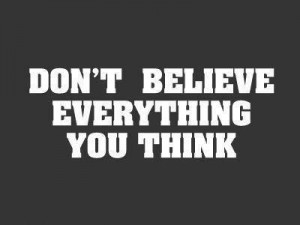
We tend to trust what goes on in our brains. After all, if you can’t trust your own brain, what can you trust?
Generally, this is a good thing – our brain has been wired to alert us to danger, attract us to potential mates, and find solutions to the problems we encounter every day.
However, there are some occasions when you may want to second guess what your brain is telling you. It’s not that your brain is purposely lying to you, it’s just that it may have developed some faulty or non-helpful connections over time as a shortcut way of simplifying the vast amount of information we process in a given day.
In the context of our thoughts and beliefs, these mistakes are referred to as “cognitive distortions.”
When you feel upset, the thoughts that make you feel bad are often illogical and distorted, even though these thoughts may seem as real as the skin on your hand!! In other words, when you feel lousy, you are nearly always fooling yourself about something, even though you aren’t aware of this. It’s as if you are wearing a strong pair of eyeglasses that distort your view of the world, or looking into a trick mirror at the amusement park that make you look too tall or too short.
 Bad feelings like depression, anxiety, guilt, hopelessness, frustration, and anger are often caused by distorted thoughts. The good news is that you can CHANGE the way you FEEL by analyzing your thinking patterns and catching your thoughts.
Bad feelings like depression, anxiety, guilt, hopelessness, frustration, and anger are often caused by distorted thoughts. The good news is that you can CHANGE the way you FEEL by analyzing your thinking patterns and catching your thoughts.
The 10 most common forms of unhelpful thinking habits are:
- ALL OR NOTHING THINKING: You look at things in absolute, black and white categories.
- OVERGENERALIZING: You view a negative event as a never ending pattern of defeat.
- MENTAL FILTER: You dwell on the negative and ignore the positives.
- DISCOUNTING THE POSITIVE: You insist that your accomplishments or positive qualities don’t count.
- JUMPING TO CONCLUSIONS: You conclude things are bad without any definitive evidence. MIND READING: You assume that people are reacting negatively to you. FORTUNE TELLING: You predict that things will turn out badly.
- MAGNIFYING OR MINIMIZING: You blow things out of proportion or you shrink their importance.
- EMOTIONAL REASONING: You reason from how you feel: “I feel like an idiot, so I must be one”.
- “SHOULD” STATEMENTS: You criticize yourself or other people with “shoulds” or “shouldn’ts”, “musts” “oughts,” and “have-tos”.
- LABELING: Instead of saying “I made a mistake”, you tell yourself, “I’m a jerk”, or “a loser”.
- BLAME: You blame yourself for something you weren’t entirely responsible for, or you blame other people and overlook ways that you contributed to a problem”.
Review these 10 unhelpful thinking styles now. Can you think of times when you were involved in some of these distortions?
We all do this form of thinking from time to time and have our own “favourite” patterns. Knowing your individual patterns is the first significant step towards feeling better. Once you can identify the distortion, you can work towards effectively challenging them, minimizing them or erasing them from your thinking.
One of the goals in Cognitive Behavioural Therapy (CBT) is to restructure your biased thoughts and beliefs and identify more balanced ways of thinking.
Practicing Mindfulness can also help you be aware of when you are in the present moment rather than “in your head” – perhaps thinking about the past or worrying about the future. Through Mindfulness we learn about DEFUSION. Defusion means becoming aware of the process of thinking itself and undermining any unnecessary influence of thoughts on behavior. Defusion involves distancing, disconnecting or seeing thoughts and feelings for what they are (streams of words, passing sensations), not what they say they are (dangers or facts).
If you are feeling a strong mood like depression, anxiety, guilt, shame or anger, there is a good chance that you have been triggered by an event. Take this cue as an opportunity to:
 STOP, STEP BACK, OBSERVE (the thoughts and feelings, what’s happening to/for the other person).
STOP, STEP BACK, OBSERVE (the thoughts and feelings, what’s happening to/for the other person).
Notice what’s happening – your thoughts, physical sensations, emotions, images, memories. Notice the way you’re interpreting what they mean, and how that’s affecting you.
affecting you.
Notice the unhelpful thoughts. It can help to say them differently, in a non-threatening way: slowly, in a squeaky or comic voice or write them down.
Identify the emotion you’re feeling, and label the unhelpful thoughts
- an evaluation or judgement
- a prediction
- a feeling or sensation
- a memory
- opinion
- an unhelpful thinking habit: mind-reading (assuming we know what others are thinking), negative filter (only noticing the bad stuff), emotional reasoning (I feel bad so it must be bad), catastrophising (imagining the worst), the internal critic etc.
Notice what you don’t normally notice – sights, sounds, sensations, thoughts, textures etc.
TAKE HOME MESSAGE: Hopefully this short piece has given you a basic understanding of cognitive distortions. These sneaky, inaccurate patterns of thinking and believing are common, but their potential impact should not be underestimated.
Even if you are not struggling with depression, anxiety, or another serious mental health issue, it doesn’t hurt to evaluate your own thoughts every now and then. The sooner you catch a cognitive distortion and mount a defense against it, the less likely it is to make a negative impact on your life.
What do you think about cognitive distortions? Have you experienced some of these yourself? How have you tackled them, whether in CBT or on your own? Would love to hear your comments.
Thanks for reading!
